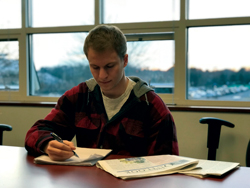Three years ago a pair of geneticists sat at a bar discussing the issue of where to store their institute’s copious amounts of research data due to the fact that storing such information on hard drives had become exceedingly expensive. What began as a mere quest to find an alternative to store DNA, protein and other genetic sequence information ended up as an exceptionally revolutionary idea: storing real-life practical files within DNA itself.
Now in 2013, these two geneticists, Ewan Birney and Nick Goldman of the European Bioinformatics Institute, have succeeded in storing a set of Shakespeare’s sonnets, a PDF of the first paper describing DNA’s double helix structure, a 26-second mp3 clip from Martin Luther King, Jr.’s “I Have a Dream” speech and a JPEG photograph of their institute-all within a molecule of DNA. They’ve published their research in Nature, one of the world’s most prestigious scientific journals.
This enormous feat renders a hopeful and exciting future for DNA storage. Such an endeavor is also likely to lead to more success because DNA is an optimal storage device, being sturdy and extremely compact.
Furthermore, storing information on DNA is relatively inexpensive, especially when compared to the cost of using external hard drives. And just as storing information on silicon chips and in hard drives was reaching its maximum point in both pushing budget costs and storage limits, this breakthrough has had excellent timing. Sophomore education major Maham Ayub said, “Such a breakthrough in DNA research is especially convenient due to the monumental use of technology in our current digital age, which is bound to become only more advanced. It is fascinating to be able to store practical files in life’s own genetic make-up and it really makes me wonder what other great accomplishments our future will hold.”
This inventive technology can be of immense assistance in our ever-advancing modern society. Numerous companies will be able to utilize DNA to store cumbersome amounts of data for a substantially lower price. Perhaps someday we may even see DNA storage devices put to practice in our own school databases at the University.
Biology professor Cara Muscio comments, “As we continually increase the rate of data production in our digital world, the need to upgrade the stability and longevity of our storage systems becomes clear. DNA storage, though in its infancy, is another fascinating example of looking to nature for efficient, persistent, and beautifully designed mechanisms that may help us achieve our wildest dreams. However, as with all discoveries, potential ethical and practical issues will need to be addressed before it is commonplace to carry around your own ‘DNA library.’”
So how does it work? Essentially, the code of the specific files Goldman and Birney selected were converted to binary code and then converted once more to the four letters of the DNA code. This step was accomplished through specialized software that Goldman wrote. It allowed the audio, photo and document file information to be encoded in the DNA nucleotide bases- adenine, guanine, cytosine and thymine.
The DNA was then subjected to a standard DNA sequencer which is a device used to determine the order of the nucleotide bases. Once the machine aligns the bases in the proper order, it can determine what is coded in that sequence of DNA. This allowed the files that Goldman and Birney encoded to be re-opened. Although they encountered slight difficulty at first, these innovative biologists were able to retrieve the encoded files with an impressive 100 percent accuracy.
However, as with all modes of change, moral and ethical issues persist. Although skeptics are justified in questioning the source of the DNA to be used and just how quickly it will be able to be integrated into modern society, it is the attempts at progress that matter.
Junior health studies and physical education major, Kinza Awan, agrees that, “This form of storage is not so farfetched. It’s so amazing as to the things we have accomplished in the last 15 years, that an idea like DNA storage doesn’t seem impossible. Yes, it is something that will take a lot of manpower and brainpower, but you never know. In 30-40 years from now, we might be using DNA to store data instead of hard drives.”
Goldman predicts that if such DNA is to be used for other practical files, then in the near future it would be possible to simply, “Stick it in the fridge or bury it in the garden or they [DNA storage companies] would store it. And they can guarantee it will be there a hundred thousand years later,” said Goldman. Such an economical mode of storage brings us not only an efficient way to potentially live our lives, but also yet another example of the seemingly limitless bounds of the human imagination.
IMAGE TAKEN from time.com



